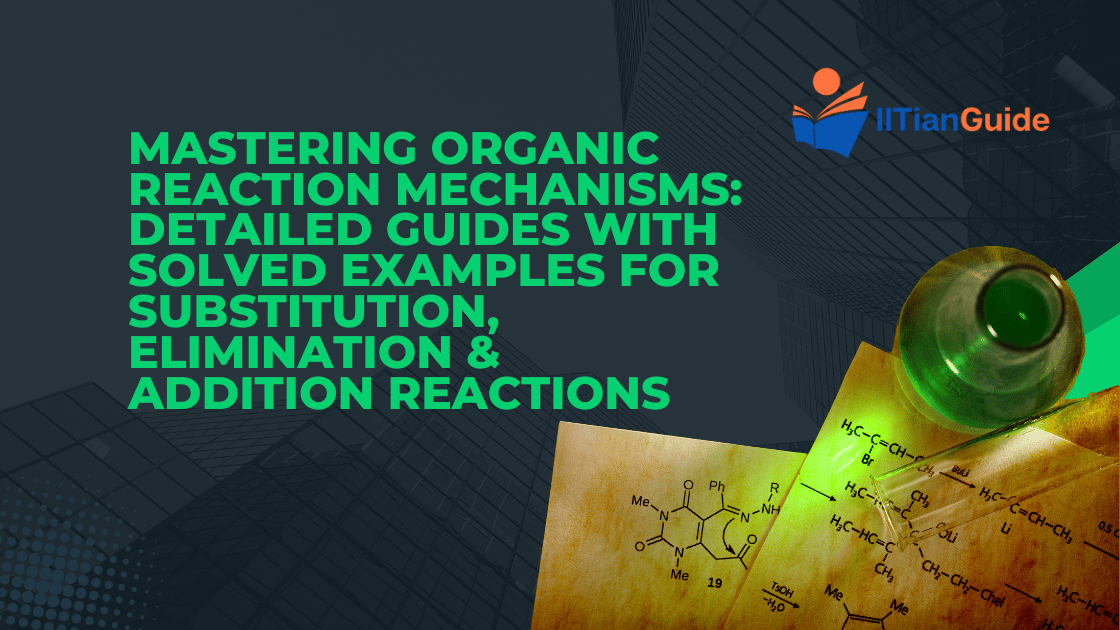Mastering Organic Reaction Mechanisms: Detailed Guides with Solved Examples for Substitution, Elimination & Addition Reactions

Organic reaction mechanisms are the backbone of mastering organic chemistry. These mechanisms help students understand how and why reactions occur, instead of relying on rote memorisation.
Whether you’re preparing for JEE, NEET, or board exams, learning reaction families like substitution, elimination, and addition reactions with their mechanisms and solved examples will boost both confidence and marks.
In this blog, we break down the most important reaction types in organic chemistry, offer concept-based guidance, and provide step-by-step solved examples to sharpen your application skills.
Why Understanding Organic Mechanisms Matters
Many students try to memorise reactions. This leads to confusion when questions are twisted in exams.
Here’s what you gain when you understand the organic reaction mechanism:
- Predict the products of unfamiliar reactions
- Solve higher-order thinking questions (especially in JEE Advanced)
- Build a strong conceptual foundation
- Master interconversion and synthesis problems
Let’s now dive into the three key reaction families: substitution, elimination, and addition reactions.
1. Substitution Reactions
What Are Substitution Reactions?
In substitution reactions, one atom or group in a molecule is replaced by another atom or group. These are commonly seen in alkyl halides and involve nucleophiles or electrophiles.
There are two main types:
- SN1 (Unimolecular Nucleophilic Substitution)
- SN2 (Bimolecular Nucleophilic Substitution)
Key Differences Between SN1 and SN2
|
Feature |
SN1 Reaction |
SN2 Reaction |
|
Mechanism |
Two-step |
One-step |
|
Intermediate |
Carbocation |
No intermediate |
|
Rate |
Depends only on substrate |
Depends on both substrate & nucleophile |
|
Stereochemistry |
Racemisation |
Inversion of configuration |
|
Preferred Substrate |
Tertiary halide |
Primary halide |
Solved Example – SN2 Mechanism
Question: Predict the product and show the mechanism:
CH₃CH₂Br + OH⁻ → ?
Solution:
- This is a primary alkyl halide → SN2 reaction is favoured.
- OH⁻ acts as a nucleophile.
- It attacks from the back side, displacing Br⁻.
- Product: CH₃CH₂OH (ethanol)
2. Elimination Reactions
What Are Elimination Reactions?
Elimination reactions involve the removal of atoms/groups from a molecule to form a double bond.
The two main types are:
- E1 (Unimolecular Elimination)
- E2 (Bimolecular Elimination)
These reactions are commonly seen in alkyl halides when treated with strong bases or heat.
E1 vs E2 – Comparison Table
|
Feature |
E1 Reaction |
E2 Reaction |
|
Steps |
Two-step |
One-step |
|
Intermediate |
Carbocation |
No intermediate |
|
Base Strength |
Weak base sufficient |
Requires strong base |
|
Favoured by |
Tertiary substrates |
Primary or secondary with bulky base |
|
Product |
Follows Zaitsev’s Rule |
May follow Zaitsev or Hoffman Rule |
Solved Example – E2 Mechanism
Question: Predict the major product:
CH₃CHBrCH₃ + NaOEt (ethoxide)
Solution:
- Secondary alkyl halide + strong base → E2 pathway
- Base abstracts β-H, Br leaves → alkene formation
- Major product: CH₂=CHCH₃ (propene)
3. Addition Reactions
What Are Addition Reactions?
Addition reactions occur when atoms are added to double or triple bonds, converting them into single or double bonds. These are common in alkenes and alkynes.
Types include:
- Electrophilic Addition (e.g., HX addition)
- Nucleophilic Addition (carbonyl compounds)
- Free Radical Addition
Electrophilic Addition to Alkenes – Step-by-Step
Example Reaction: CH₂=CH₂ + HBr → ?
Mechanism:
- Alkene acts as nucleophile, attacks H⁺
- Carbocation intermediate forms on most stable carbon
- Br⁻ attacks the carbocation
- Product: CH₃CH₂Br (ethyl bromide)
Follows Markovnikov’s Rule – H adds to carbon with more Hs.
Solved Example – Nucleophilic Addition to Carbonyl
Question: Predict the product:
CH₃CHO + HCN → ?
Solution:
- Nucleophile: CN⁻
- Attacks carbonyl carbon of acetaldehyde
- Forms: CH₃CH(OH)CN (cyanohydrin)
Tips to Master Organic Reaction Mechanisms
Here are a few strategies to strengthen your grip on organic reactions:
1. Learn the Electron Flow
- Use curved arrows to show movement of electrons
- Understand where electrons come from and where they go
2. Understand Stability of Intermediates
- Carbocation stability (3° > 2° > 1°)
- Resonance and inductive effects
3. Use Flowcharts and Mechanism Maps
- Visualise pathways
- Build summary sheets with reagent → condition → product
4. Practice Solved Examples Regularly
- Use NCERT, coaching modules, and PYQs
- Focus on concept application, not memorisation
Conclusion
Mastering organic reaction mechanisms is not about learning 500 reactions. It’s about understanding why they happen. When you grasp the substitution, elimination, and addition mechanisms deeply, you’ll be able to tackle even the toughest JEE or board-level questions confidently.
Focus on conceptual clarity, practice with solved examples, and draw mechanism arrows regularly. That’s how you apply, not memorise.
Frequently Asked Questions (FAQs)
Q1. What’s the best way to remember organic reaction mechanisms?
Answer: Focus on understanding the electron flow and practice drawing arrow-pushing mechanisms. Build a mechanism map and revise it often.
Q2. How do I know whether a reaction is SN1, SN2, E1 or E2?
Answer: Look at the substrate type, strength of the base/nucleophile, solvent, and reaction conditions (heat, etc.). Refer to the comparison tables given above.
Q3. Are solved examples really necessary?
Answer: Yes. Without practising solved examples, it’s easy to forget steps. Examples help you develop problem-solving skills and apply theory.
Q4. Can I use NCERT for mechanism-based questions?
Answer: NCERT is good for basics. But for JEE, supplement with books like MS Chauhan, Solomons, or coaching material for deeper insights.
Q5. Which topics should I master first?
Answer: Start with nucleophilic substitution, elimination reactions, and electrophilic addition to alkenes. These form the core of most JEE questions.

